1994 BUICK PARK AVENUE high beam
[x] Cancel search: high beamPage 14 of 324
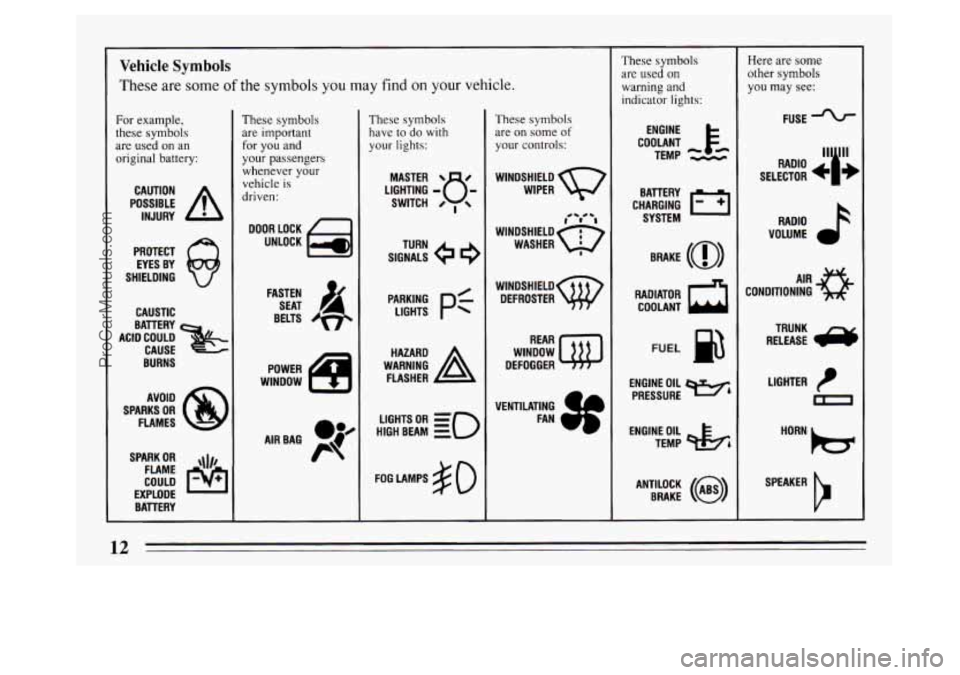
Vehicle Symbols
These are some of the symbols you may find on your vehicle.
For example,
these symbols are used on an
original battery:
POSSIBLE A
CAUTION
INJURY
PROTECT EYES BY
SHIELDING
CAUSTIC
BURNS AVOID
SPARKS
OR
FLAMES
SPARK
OR ,111,
COULD FLAME
EXPLODE BATTERY
These symbols are important
for you and
your passengers
whenever your
vehicle
is
driven:
DOOR LOCK
UNLOCK
FASTEN SEAT
4
BELTS
POWER
WINDOW
These symbols
have to
do with
your lights:
WARNING A
HAZARD
FLASHER
HIGH BEAM OR
= -0
FOG LAMPS $0
These symbols
are on some
of
your controls:
WINoSHIELD WIPER w
WINDSHIELD
DEFROSTER
WINDOW
DEFOGGER
VENTILATING FAN
These symbols
are
used on
warning and indicator lights:
CHARGING 1-1
BATTERY
SYSTEM
RADIATOR
a
COOLANT
FUEL
ENGINE OIL
PRESSURE
Wb
TEMP OIL &
ANTILOCK (a)
BRAKE
Here are some
other symbols you may see:
FUSE
RADIO
"i"
SELECTOR fi
RADIO >
VOLUME
LIGHTER
n
12
ProCarManuals.com
Page 65 of 324

Part 2 Features and Controls
Here you can learn about the many standard and optional features on your Buick. and information on starting. shifting
and braking
. Also explained are the instrument panel and the warning systems that tell you if everything is working
properly
.. and what to do if you have a problem .
Part 2 includes:
Keys ........................................................................\
.... 64
DoorLocks
....................................................................... \
65
NewVehicleBreak-In
.............................................................. 79
StartingtheEngine
................................................................. 81
Shifting the Transaxle .............................................................. 83
Windows ........................................................................\
. 93
93
Turn Signal/Headlight Beam Lever
.................................................... 94
Headlight High-Low Beam Changer
.............................................. 96
Windshield Wipermasher
...................................................... 96
Cruisecontrol
................................................................ 98
Headlights
........................................................................\
103
Mirrors
........................................................................\
.. 108
Instrumentpanel ................................................................... 119
Speedometer and Odometer ..................................................... 119
Warning Lights, Gages and Indicators ............................................. 120
TiltSteeringWheel ................................................................
. . 63
ProCarManuals.com
Page 96 of 324
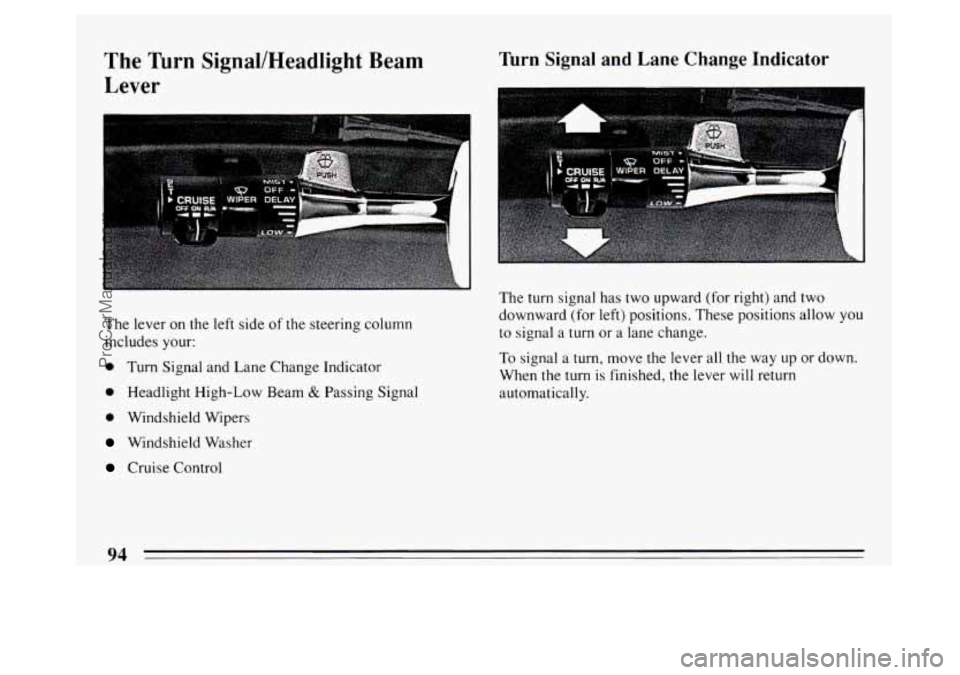
The Turn SignallHeadlight Beam
Lever
The lever on the left side of the steering column
includes your:
0 Turn Signal and Lane Change Indicator
0 Headlight High-Low Beam & Passing Signal
0 Windshield Wipers
Windshield Washer
Cruise Control
Turn Signal and Lane Change Indicator
I'
The turn signal has two upward (for right) and two
downward (for left) positions. These positions allow
you
to signal a turn or a lane change.
To signal a turn, move the lever all the way
up or down.
When the turn
is finished, the lever will return
automatically.
94
ProCarManuals.com
Page 97 of 324
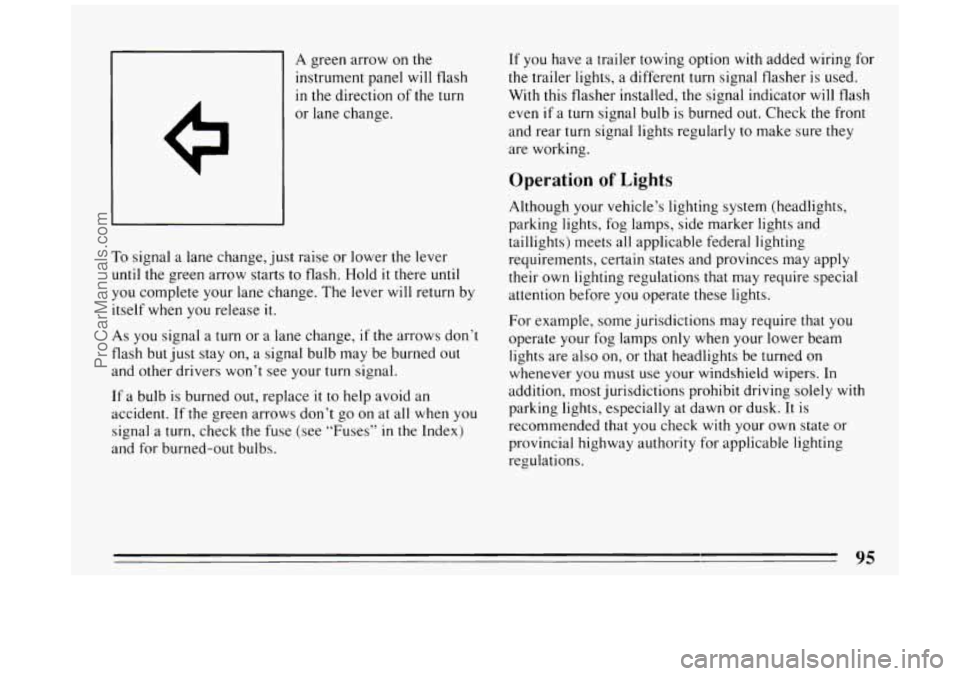
A green arrow on the
instrument panel will flash
in the direction of the turn
To signal a lane change, just raise or lower the lever
until the green arrow starts to flash. Hold it there until
you complete your lane change. The lever will return by
itself when you release
it.
As you signal a turn or a lane change, if the arrows don’t
flash but just stay on, a signal bulb may be burned out
and other drivers won’t see your turn signal.
If a bulb is burned out, replace it to help avoid an
accident. If the green arrows don’t go on at all when you
signal a
turn, check the fuse (see “Fuses” in the Index)
and for burned-out bulbs. If you
have a trailer towing option
with added wiring for
the trailer lights, a different turn signal flasher is used.
With this flasher installed, the signal indicator
will flash
even
if a turn signal bulb is burned out. Check the front
and rear turn signal lights regularly to make sure they
are working.
Operation of Lights
Although your vehicle’s lighting system (headlights,
parking lights, fog lamps, side marker lights and
taillights) meets all applicable federal lighting
requirements, certain states and provinces may apply
their own lighting regulations that may require special
attention before you operate these lights.
For example, some jurisdictions may require that you
operate your fog lamps only when your lower beam
lights are also on, or that headlights be turned on
whenever you must
use your windshield wipers. In
addition, most jurisdictions prohibit driving solely
with
parking lights, especially at dawn or dusk. It is
recommended that you check with your own state or
provincial highway authority for applicable lighting
regulations.
95
ProCarManuals.com
Page 98 of 324
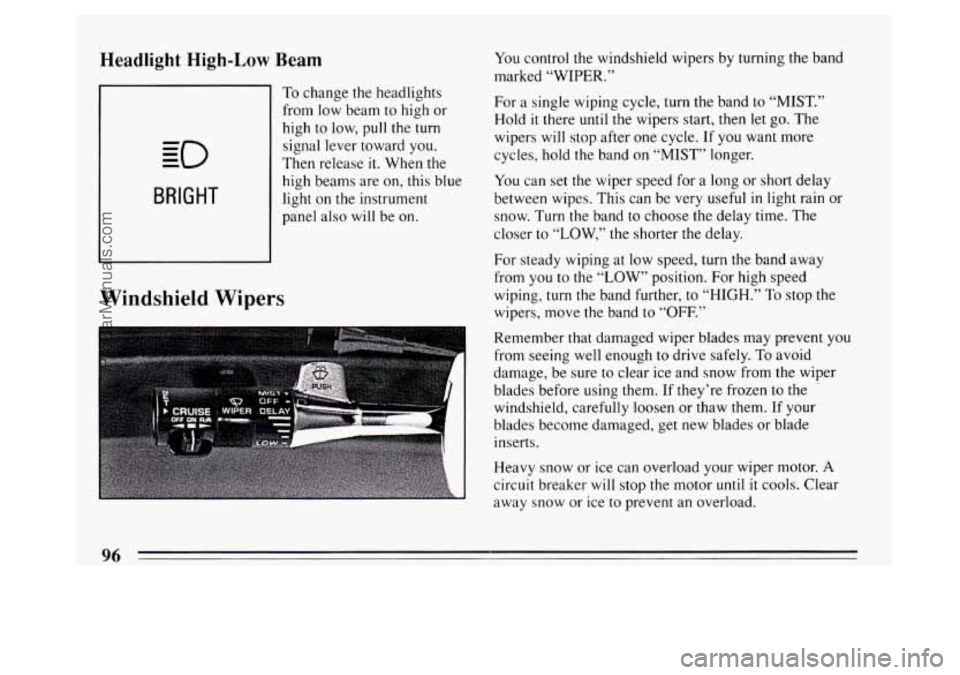
Headlight High-Low Beam
BRIGHT
Windshield Wipers
To change the headlights
from low beam to high or
high to low,
pull the turn
signal lever toward you.
Then release
it. When the
high beams are on, this blue
light on the instrument
panel also will be on. You
control the windshield wipers by turning the band
marked
“WIPER.”
For a single wiping cycle, turn the band to “MIST.”
Hold
it there until the wipers start, then let go. The
wipers will stop after one cycle. If you want more
cycles, hold the band on “MIST” longer.
You can set the wiper speed for a long or short delay
between wipes. This can be very useful
in light rain or
snow. Turn the band to choose the delay time. The
closer to
“LOW,” the shorter the delay.
For steady wiping at low speed, turn the band away
from you to the
“LOW” position. For high speed
wiping, turn the band further,
to “HIGH.” To stop the
wipers, move the band to “OFF.”
Remember that damaged wiper blades may prevent you
from seeing well enough to drive safely.
To avoid
damage, be sure to clear ice and snow from the wiper
blades before using them. If they’re frozen to
the .
windshield, carefully loosen or thaw them. If your
blades become damaged, get new blades or blade
inserts.
Heavy snow or ice can overload your wiper motor.
A
circuit breaker will stop the motor until it cools. Clear
away snow or ice to prevent an overload.
96
ProCarManuals.com
Page 109 of 324

Lamp Monitors (Option)
This system will let you know when certain exterior
light bulbs fail. When you start your car all eight lights
come on briefly to show that the system is working.
When a bulb Fails an indicator
will flash for several
seconds and then stay on
until the failed bulb is replaced
and
lit. For example, if a burned out back-up light bulb
is replaced, the indicator for back-up lamps will stay on
until the transaxle is put in reverse with the ignition on.
The bulbs are monitored only while they are being used.
If you have recently had a low battery condition or the
battery has been disconnected and reconnected, the
indicators will flash when
you turn the ignition switch to
RUN. Turning on the parking lamps will return the lamp
monitor system
to normal operation.
Bulbs Monitored
Indicator
High Beam
Low Beam Left Turn
Right Turn
Tail
Parking stop
Backup
Bulbs Monitored
Both Headlight
High Beams
Both Headlight
Low Beams
1 Front Left Turn/Park
2 Rear Left Turn/Stop
1 Front Right Turnpark
2 Rear Right Turn/Stop
2 Tail Only
4 Tail/Turn
Right and Left Rear
Side Marker
2 License
2 Park/Turn
2 Front Park
Right and Left Front Side Marker
4 Rear Stop/Turn
1 Center High Mounted
2 Back up
107
ProCarManuals.com
Page 178 of 324
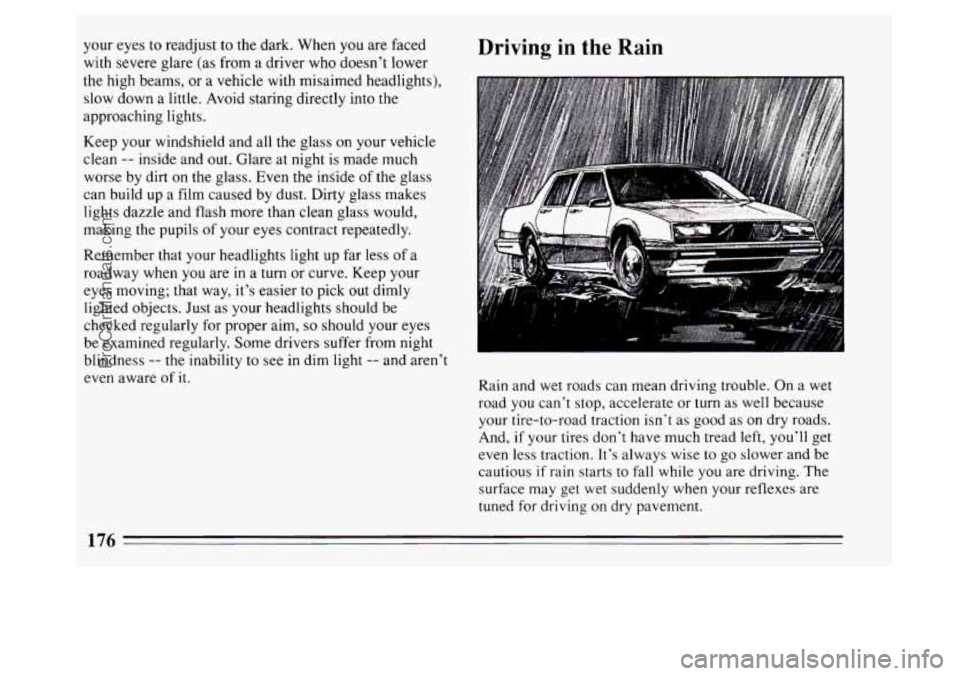
your eyes to readjust to the dark. When you are faced
with severe glare (as from a driver who doesn’t lower
the high beams, or a vehicle with misaimed headlights),
slow down a little. Avoid staring directly into the
approaching lights.
Keep your windshield and all the glass on your vehicle
clean
-- inside and out. Glare at night is made much
worse by dirt
on the glass. Even the inside of the glass
can build up a film caused by dust. Dirty glass makes
lights dazzle and flash more than clean glass would,
making the pupils of your eyes contract repeatedly.
Remember that your headlights light up far less of a
roadway when you are
in a turn or curve. Keep your
eyes moving; that way, it’s easier to pick out dimly
lighted objects. Just as your headlights should be
checked regularly for proper aim,
so should your eyes
be examined regularly. Some drivers suffer from night
blindness
-- the inability to see in dim light -- and aren’t
even aware
of it.
Driving in the Rain
Rain and wet roads can mean driving trouble. On a wet
road you can’t stop, accelerate or turn as well because
your tire-to-road traction isn’t as good
as on dry roads.
And,
if your tires don’t have much tread left, you’ll get
even less traction. It’s always wise to go slower and be
cautious
if rain starts to fall while you are driving. The
surface may get wet suddenly when your reflexes are
tuned for driving
on dry pavement.
176
ProCarManuals.com
Page 180 of 324
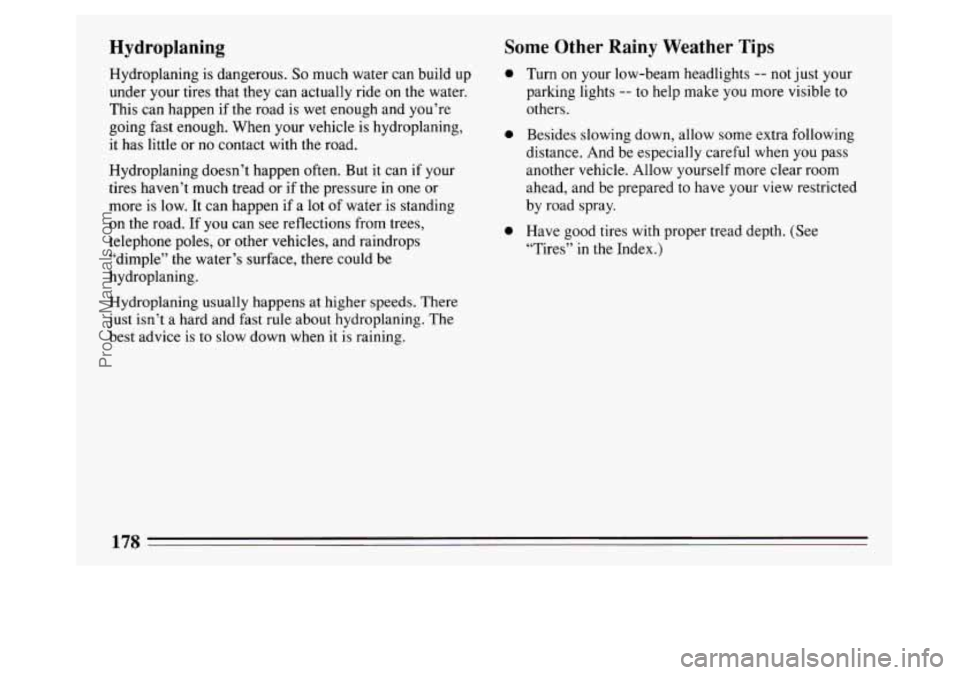
Hydroplaning
Hydroplaning is dangerous. So much water can build up
under your tires that they can actually ride on the water.
This can happen if the road is wet enough and you’re
going fast enough. When your vehicle is hydroplaning,
it has little or no contact with
the road.
Hydroplaning doesn’t happen often. But it can
if your
tires haven’t much tread or if the pressure in
one or
more is low. It can happen if a lot of water is standing
on the road. If you can see reflections from trees,
telephone poles, or other vehicles, and raindrops
“dimple” the water’s surface, there could be
hydroplaning.
Hydroplaning usually happens at higher speeds. There
just isn’t a hard and fast rule about hydroplaning. The
best advice is
to slow down when it is raining.
Some Other Rainy Weather Tips
0
0
0
Turn on your low-beam headlights -- not just your
parking lights
-- to help make you more visible to
others.
Besides slowing down, allow some extra following
distance. And be especially careful when
you pass
another vehicle. Allow yourself more clear room
ahead, and be prepared
to have your view restricted
by road spray.
Have good tires
with proper tread depth. (See
“Tires” in the Index.)
178
ProCarManuals.com